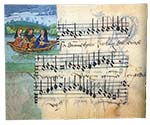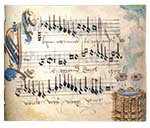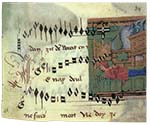Cancioniero de Juana la Loca

One of the smallest facsimiles in our collection (at only 11 by 9 cm. when closed),this little songbook is actually one of a set of four partbooks. This book contains the superius, or highest voice part for the twenty-two songs included within. One of the other partbooks is lost, while the remaining two are incomplete. Nevertheless, information in these other books helps to date the set to around 1511. An unusual mix of French, Latin, and Flemish works indicates that this set originated in the Flemish region of Belgium. The illuminated miniatures and format of the book are similar to those of books of hours (devotional books) of Queen Joanna I of Castile (1479-1555, nicknamed “Juana la Loca” or “Joanna the Mad”). Thus scholars have concluded that this book was commissioned by the queen.
This facsimile of the songbook was created by Patrimonio Ediciones. The miniatures are faithfully recreated in full color and highlighted with gold and silver, and the green, tooled leather binding recreates the original binding. One of a limited edition of 999 copies, this beautiful facsimile is a treasured addition to the library’s collection.
(Click on each image to enlarge. Image will open in a new window.)





